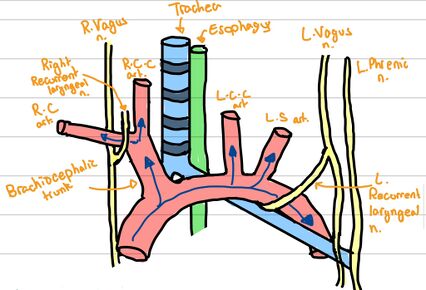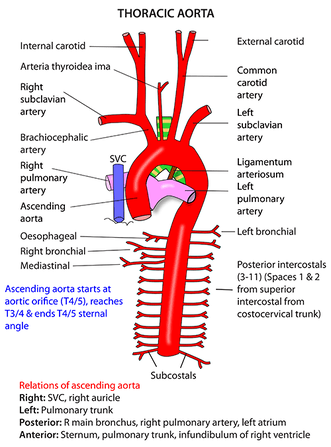Aorta - Course, syntopy and Branches
From WikiLectures
The aorta, the body's largest artery, receives cardiac output from the left ventricle and distributes oxygenated blood throughout the body via systemic circulation. It is segmented into four sections:
- Ascending aorta
- Aortic arch
- Thoracic aorta
- Abdominal aorta.
Classified as a large elastic artery, it plays a crucial role in maintaining blood flow and pressure regulation throughout the body.
1. Ascending Aorta.[1][edit | edit source]
- Origin: Aortic orifice of the left ventricle
- Course: Ascends around 5 cm to the sternal angle, forming the aortic arch, and continues through the superior mediastinum region.
- Branches: Contains left and right aortic sinuses dilation in the ascending aorta at the level of the aortic valve, giving rise to the right and left coronary arteries.
Relation: Runs parallel to the pulmonary trunk during its ascent.
Diameter: Approximately 2.5 cm
2. Aortic Arch[1][edit | edit source]
- Origin: The aortic arch is a continuation of the ascending aorta and begins at the level of the 2nd sternocostal joint.
- Course: It curves posteriorly on the left side of the trachea and esophagus, superior to the left main bronchus. It terminates at the level of the 4th thoracic vertebra (T4).
- Branches:
- Brachiocephalic Trunk:
- Right Common Carotid Artery
- Right Subclavian Artery
- Left Common Carotid Artery
- Left Subclavian Artery
- Syntopy:
- Left Anterior:
- Left Phrenic Nerve
- Left Vagus Nerve (Gives rise to left recurrent laryngeal nerve, which hooks under the arch of the aorta from anterior to posterior)
- Posterior:
- Trachea
- Deep Cardiac Plexus
- Right Recurrent Laryngeal Nerve
- Esophageal Branches
- Thoracic Duct
- Thoracic vertebrae (T1 to T4)
- Inferior:
- Pulmonary Bifurcation
- Left Main Bronchus
- Ligamentum Arteriosum
- Left Recurrent Laryngeal Nerve
- Left Anterior:
3. Thoracic Aorta[1][edit | edit source]
- Also Known As: Descending Aorta
- Origin: It continues from the aortic arch at the level of the 4th thoracic vertebra (T4).
- Course: Descending in the posterior mediastinum, to the left of the vertebral column, it gradually moves toward the center.
- Branches (Descending Order):
- Bronchial Arteries: Supplying bronchial tissue
- Mediastinal Arteries: Providing blood to lymph glands and loose areolar tissue in the mediastinum
- Esophageal Arteries: Supplying the esophagus
- Pericardial Arteries: Supplying dorsal portion of pericardium
- Superior Phrenic Arteries: Supplying the superior portion of the diaphragm
- Intercostal Arteries: Supplying the 9 intercostal spaces except the 1st and 2nd intercostal spaces
- Subcostal Arteries: Providing blood to the muscles of the flat abdominal wall
- ↑ a b c TeachmeAnatomy - Aorta https://teachmeanatomy.info/abdomen/vasculature/arteries/aorta/


